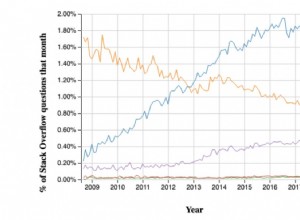crosstab() funzione con due parametri.
Dovrebbe funzionare in questo modo, per ottenere valori per il 2012:
SELECT * FROM crosstab(
$$SELECT testname, to_char(last_update, 'mon_YYYY'), count(*)::int AS ct
FROM tests
WHERE current_status = 'FAILED'
AND last_update >= '2012-01-01 0:0'
AND last_update < '2013-01-01 0:0' -- proper date range!
GROUP BY 1,2
ORDER BY 1,2$$
,$$VALUES
('jan_2012'::text), ('feb_2012'), ('mar_2012')
, ('apr_2012'), ('may_2012'), ('jun_2012')
, ('jul_2012'), ('aug_2012'), ('sep_2012')
, ('oct_2012'), ('nov_2012'), ('dec_2012')$$)
AS ct (testname text
, jan_2012 int, feb_2012 int, mar_2012 int
, apr_2012 int, may_2012 int, jun_2012 int
, jul_2012 int, aug_2012 int, sep_2012 int
, oct_2012 int, nov_2012 int, dec_2012 int);
Trova una spiegazione dettagliata in questa domanda correlata.
Non ho eseguito il test. Come ha commentato @Craig, i valori del campione sarebbero stati d'aiuto.
Testato ora con il mio banco di prova.
Non visualizzare valori NULL
Il problema principale (che i mesi senza righe non verrebbero affatto visualizzati) è evitato dal crosstab() funzione con due parametri.
Non puoi usare COALESCE nella query interna, perché NULL i valori sono inseriti da crosstab() si. Potresti...
1. Avvolgi il tutto in una sottoquery:
SELECT testname
,COALESCE(jan_2012, 0) AS jan_2012
,COALESCE(feb_2012, 0) AS feb_2012
,COALESCE(mar_2012, 0) AS mar_2012
, ...
FROM (
-- query from above)
) x;
2. LEFT JOIN dalla query principale all'elenco completo dei mesi.
In questo caso, non hai bisogno del secondo parametro per definizione.
Per un intervallo più ampio potresti usare generate_series() per creare i valori.
SELECT * FROM crosstab(
$$SELECT t.testname, m.mon, count(x.testname)::int AS ct
FROM (
VALUES
('jan_2012'::text), ('feb_2012'), ('mar_2012')
,('apr_2012'), ('may_2012'), ('jun_2012')
,('jul_2012'), ('aug_2012'), ('sep_2012')
,('oct_2012'), ('nov_2012'), ('dec_2012')
) m(mon)
CROSS JOIN (SELECT DISTINCT testname FROM tests) t
LEFT JOIN (
SELECT testname
,to_char(last_update, 'mon_YYYY') AS mon
FROM tests
WHERE current_status = 'FAILED'
AND last_update >= '2012-01-01 0:0'
AND last_update < '2013-01-01 0:0' -- proper date range!
) x USING (mon)
GROUP BY 1,2
ORDER BY 1,2$$
)
AS ct (testname text
, jan_2012 int, feb_2012 int, mar_2012 int
, apr_2012 int, may_2012 int, jun_2012 int
, jul_2012 int, aug_2012 int, sep_2012 int
, oct_2012 int, nov_2012 int, dec_2012 int);
Test case con dati campione
Ecco un test case con alcuni dati di esempio che l'OP non è riuscito a fornire. L'ho usato per testarlo e farlo funzionare.
CREATE TEMP TABLE tests (
id bigserial PRIMARY KEY
,testname text NOT NULL
,last_update timestamp without time zone NOT NULL DEFAULT now()
,current_status text NOT NULL
);
INSERT INTO tests (testname, last_update, current_status)
VALUES
('foo', '2012-12-05 21:01', 'FAILED')
,('foo', '2012-12-05 21:01', 'FAILED')
,('foo', '2012-11-05 21:01', 'FAILED')
,('bar', '2012-02-05 21:01', 'FAILED')
,('bar', '2012-02-05 21:01', 'FAILED')
,('bar', '2012-03-05 21:01', 'FAILED')
,('bar', '2012-04-05 21:01', 'FAILED')
,('bar', '2012-05-05 21:01', 'FAILED');




